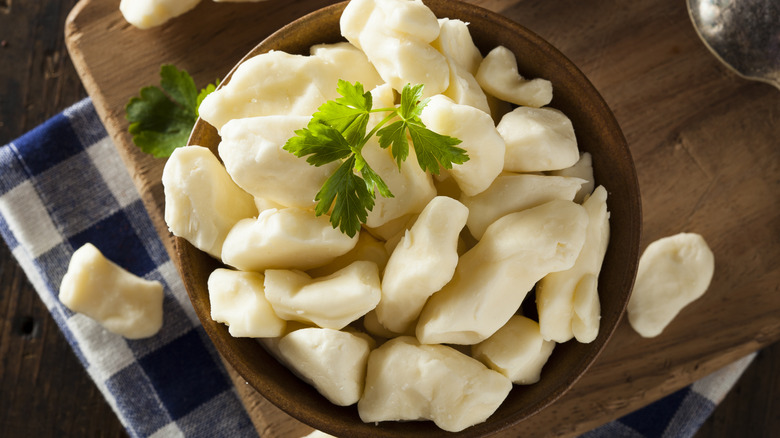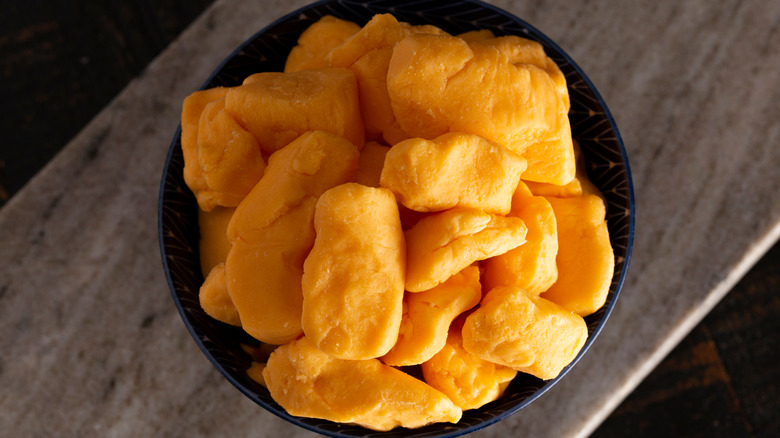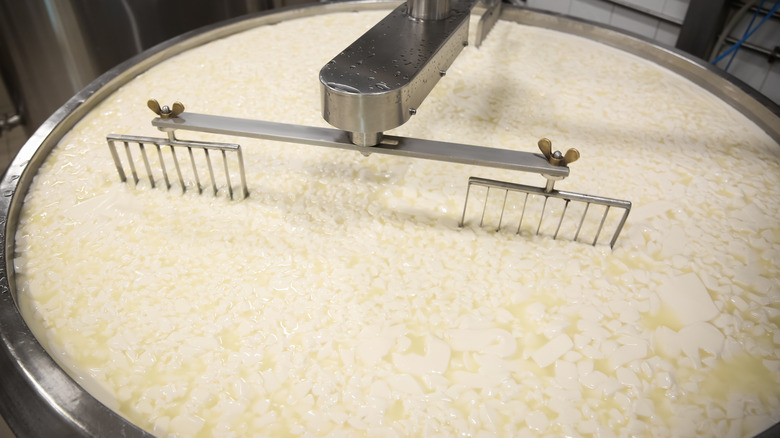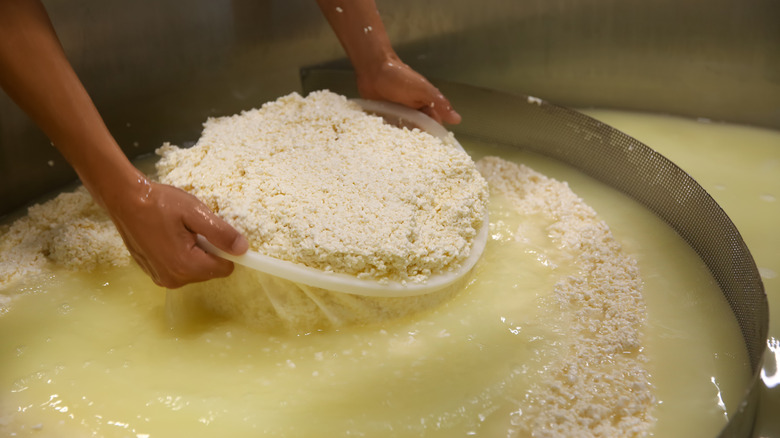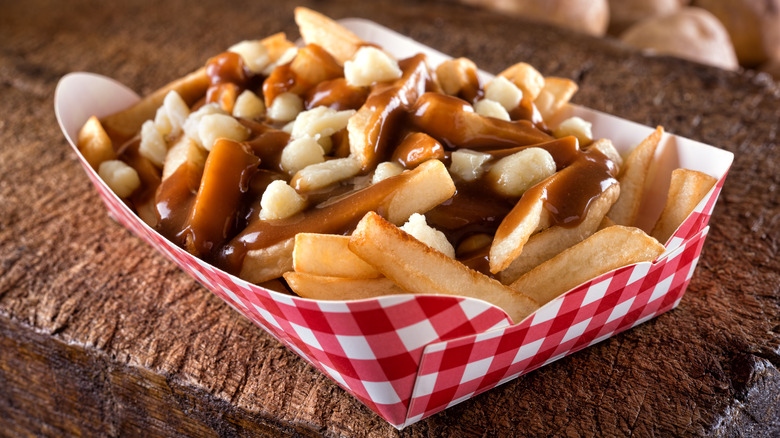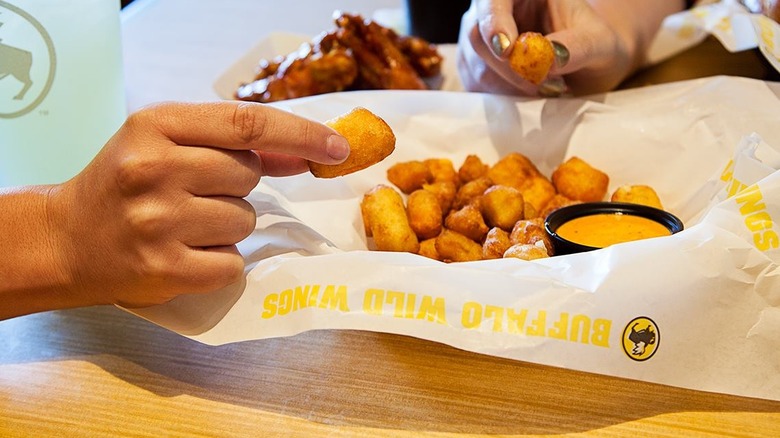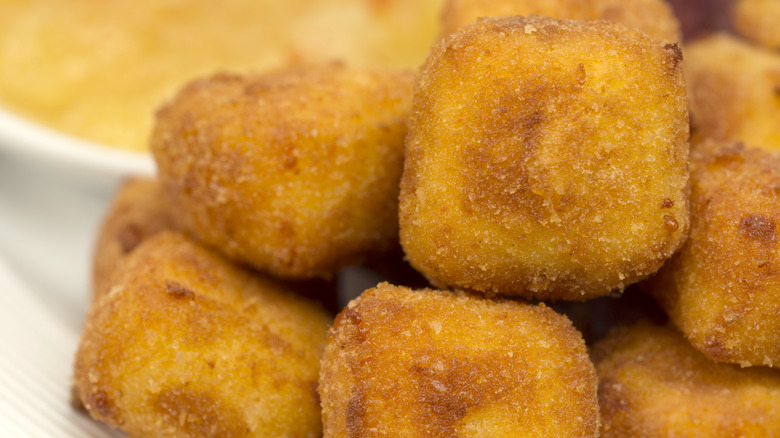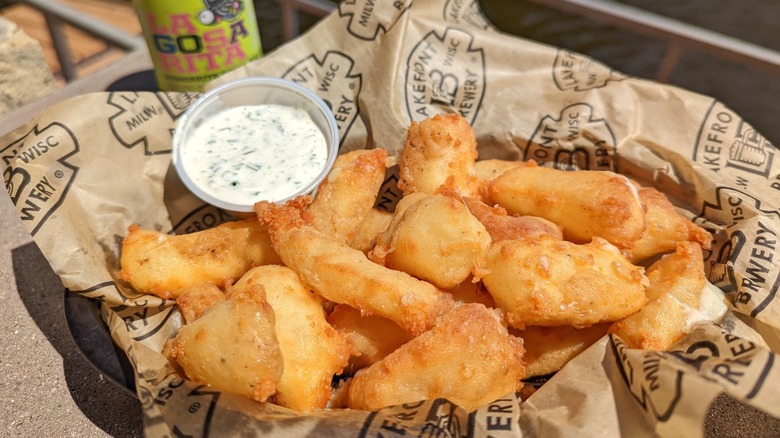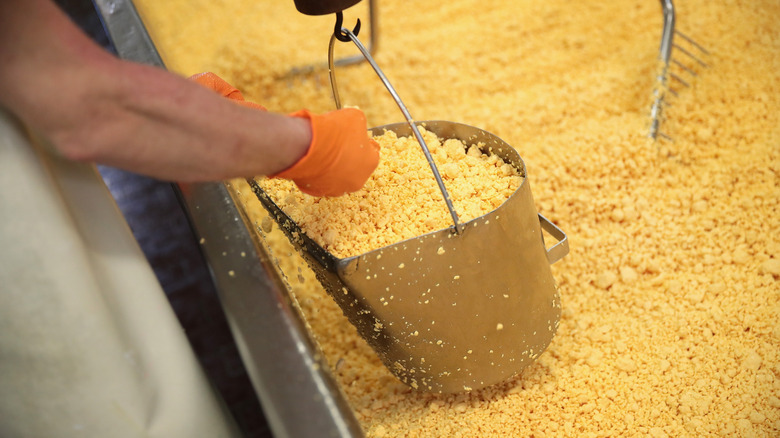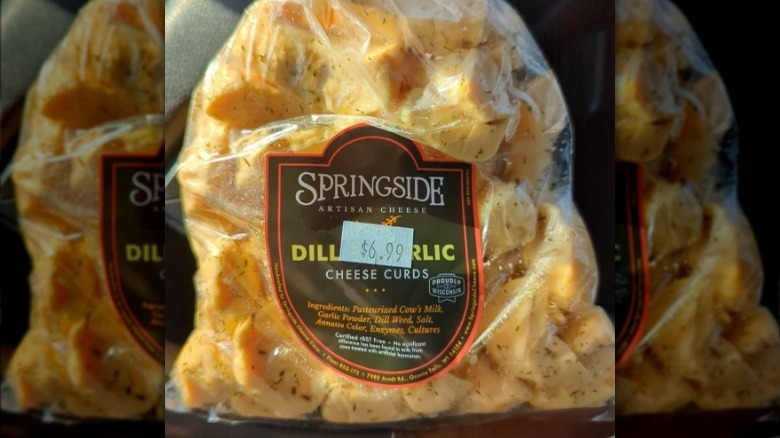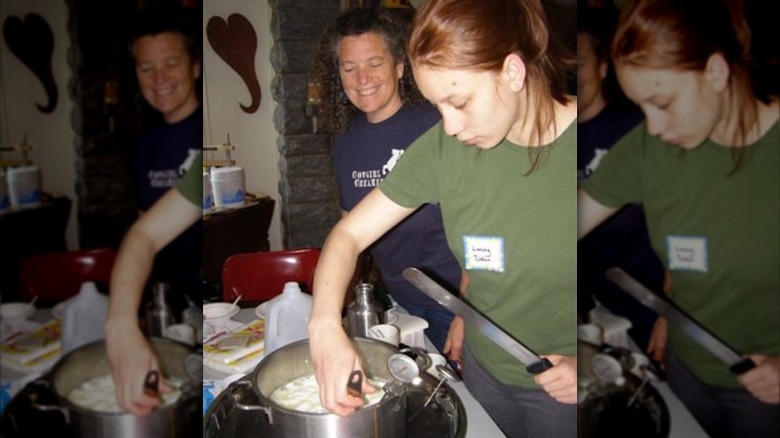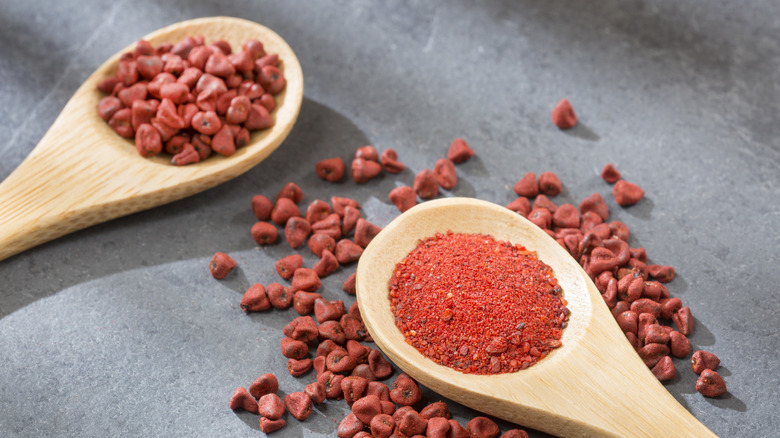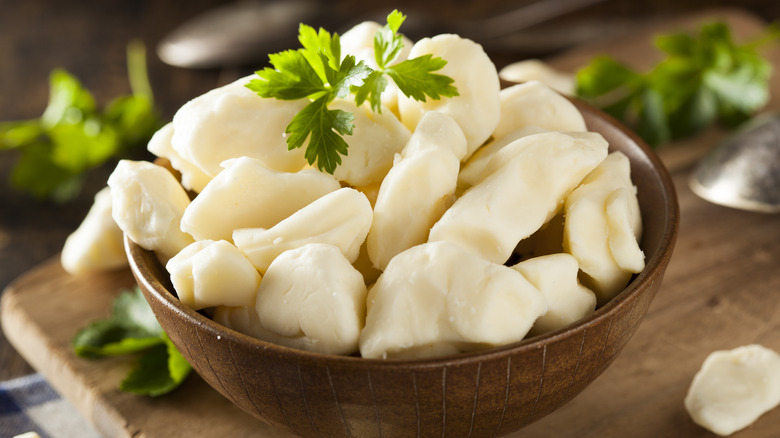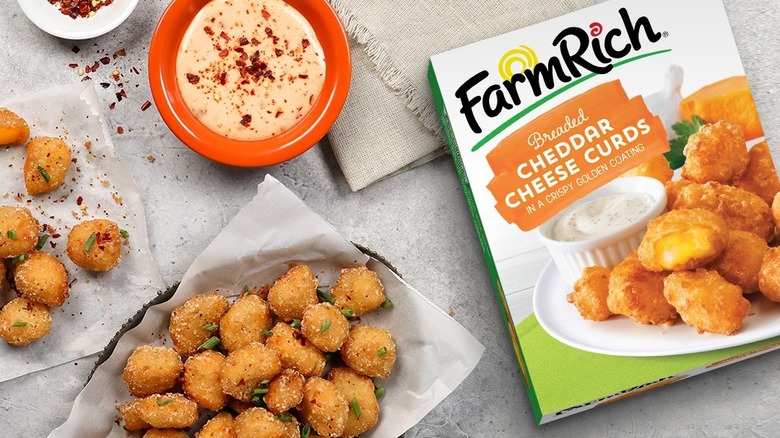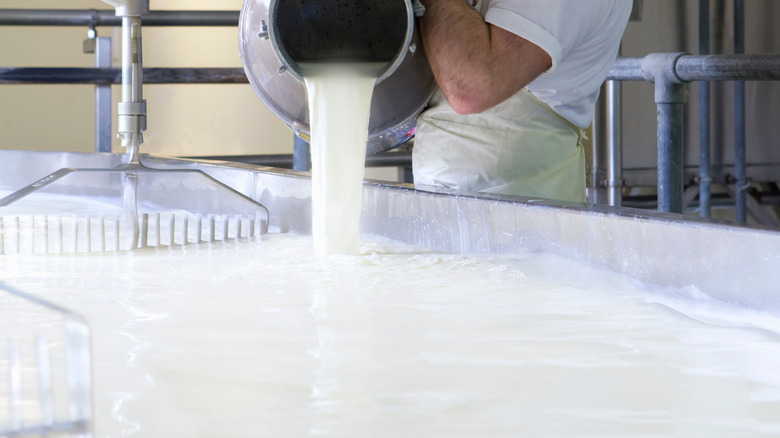14 Things To Know About Cheese Curds
If you were to redesign the food pyramid around the state diet of Wisconsin, it would be built on a foundation of cheese; blocks of other dairy products, meat, and beer would fill in the rest of the space. While we love cheddar and smoked gouda on any charcuterie board, Wisconsinites also have a deep love for another cheese product with a maybe less delicious-sounding name: cheese curds.
Cheese curds are not only delicious, but they also have a rather hearty history. We also like how flexible the curds are and that they can be enjoyed by the handful straight from the bag, flavored, battered, and fried, provide garnish for a savory drink, and even hang out in a salad. However you feel about these small snacks, one thing is clear: There is a whole lot more to the cheese curd than meets the eye. Knowing a bit more about this delicious savory treat can help you select a better curd — possibly the best in your town.
Cheese curds are the stuff of legends
These squeaky balls of cheese are very popular in Wisconsin — so much so you may assume they originated from some small town in the rural dairyland. However, cheese curds' origins are somewhat unclear and relegated to the stuff of legends.
Pure Dairy explains that the first cheese curds may have been accidentally discovered by a traveler who was making their way across a Middle-Eastern desert, and after quite a distance, they went to drink the milk they had brought with them. Unfortunately, they found not fresh milk, but a whole bunch of cheese curds.
This finding would have certainly been disheartening and may not have resulted in the best-tasting cheese curd, but the industry has progressed substantially since then. Now, many cheese makers find it relatively easy to make curds as part of the production process. As a result, you'll find bags of fresh cheese curds around the country in grocery and artisanal cheese stores. Many pubs even serve this treat, fried and golden with a side of marinara or ranch.
They come from the cheese making process
Cheese is one of those foods that enhance nearly any dish you add it to. Plus, it tastes delectable on its own. So it may not be surprising to hear that these tasty curds form as a result of the cheese-making process.
When producing the dairy product, part of the procedure is straining the cheese curds out of the whey. Proudly Wisconsin Cheese states that these little morsels form after additives and milk merge, making the liquid coagulate. Then, heat is added, and the liquid whey separates. After a little bit of time, the curds get hard and form a rubbery texture. Cheesemakers even flavor these cheese byproducts with different specialty offerings. From there, you can add them to other recipes or even feature them on their own. When cold, these delightful little bits taste and feel entirely different than when they are warm.
Fresh cheese curds squeak
When shopping, you can tell when certain produce is ripe when it smells or feels a particular way. When cheese curds are fresh, you can actually hear them because they will make a little squeaking sound when you bite into a piece.
Cheese curds squeak when you bite into them because the calcium and protein of the treat meet your tooth enamel. If your curds have a low pH, the noise will be less prominent, but if it's higher, it will be more profound. For most cheese curds, this little sound will persist between three to five days.
If they no longer squeak, there could be a few reasons. For one, your cheese curds may not be as fresh, or it could just be that some baby cheddar didn't keep its squeakiness for quite as long. Unfortunately, there could be another more dubious reason your curds aren't making noises anymore. In trying to fake out the unwitting, some companies may cut cheese into curd shapes to form fake cheese curds. Cheese that is simply cut just won't squeak.
Poutine requires cheese curds
French fries are pretty delicious, and there are many different ways to dress them up. Most fry lovers will tell you that cheese and fries were made for each other, but you shouldn't limit those additions to yellow "plastic cheese." An even better option can take the classic side to new heights.
While Wisconsin may love cheese curds, it's far from the only place obsessed with this tasty treat. One of our personal favorites is the Canadian dish known as poutine. This fun-sounding snack is simple but unreasonably tasty. There are three ingredients: French fries, cheese curds, and gravy. And while all elements are required, the cheese curds are the ingredient you simply cannot skip when making poutine.
Furthermore, it is absolutely critical to have fresh curds if you want delicious poutine. Ideally, you'll want cheese curds that have been made within 24 hours. In other words, they should still be squeaky when you place them on top of the fries. If you have super fresh curds, you don't need to refrigerate them before assembling the dish. Once you add warm gravy on top, they will also start to have a little melty consistency in some places.
Pubs often serve them fried
Poutine is delicious, but it's just one way you can feature cheese curds as a yummy dish. You can also enjoy them fried. While poutine includes fresh cheese curds, this version is battered, fried, and served with a dipping sauce. This warm and tasty dish may just become a favorite go-to appetizer.
With so many restaurants and pubs offering them, you will surely find a favorite take on this fried snack. However, Buffalo Wild Wings seems to have the stand-out choice in terms of chain offerings, according to a Mashed survey. Not only do they taste delicious on their own, but if you pair them with one of Buffalo Wild Wing's famous sauces, you can elevate that delicious cheesy flavor to new heights. An appetizer order from Buffalo Wild Wings naturally includes a little cup of Southwestern Ranch, but you could always switch this out if you wanted to.
Fried cheese curds aren't very healthy
Like many delicious dishes, unfortunately, fried cheese curds aren't the healthiest option on the menu. Another popular chain that offers tasty cheese curds is Culver's, but you might want to think twice about ordering them from here because it is certainly an indulgent food.
If you were to order a large basket of cheese curds, you'd be enjoying a cheesy 1,020 calories and 2,460 milligrams of sodium. Of course, this number goes down if you share these fried bites with friends, but you'll simply be sharing those calories. However, while they may not be healthy, we still recommend giving these cheese curds a try. And if you can order them on October 15th, you could also honor the chain's own holiday celebrating this delicious side: National Cheese Curd Day. You know that a snack with its own special day will be something extra special.
Milwaukeeans love them
Milwaukee, Wisconsin, is a bustling town of sports, great beer, fabulous music, and delicious cheese. Since curds are a part of the cheese-making process, it would make sense that they are also a prominent feature and one of the foods you have to try here.
Most locals can point you in the direction of not only the best fresh cheese curds in the city but also which pub offers the tastiest fried curds. Since Milwaukee is a social city, they are typically served to be shared with friends over ice-cold pints. For that reason, you'll find delicious offerings at nearly every bar, restaurant, and brewery throughout the city. Some of our favorites come from Lakefront Brewery. It is even known to get creative with its curds; the Milwaukee Journal Sentinal reports that the brewery has previously offered pumpkin pie cheese curds during pumpkin spice season. The seasonal snack came with a side of beer caramel as one of its special offerings on Thursday.
If you're looking for fresh cheese curds, stop by the Wisconsin Cheese Mart in downtown Milwaukee. There, you'll find a large variety to give you the full experience.
Cheese curds are commonly made from cheddar cheese
Once you've grown accustomed to the idea that cheese curds are a part of the cheese-making process, you may wonder what type of cheese they're made from.
Depending on the color of the curds, you may expect that they come from different types of cheese. However, authentic cheese curds are actually just a form of baby cheddar. The color can vary due to various additives; however, on the whole, the base of cheese curds is most often cheddar. What you taste in these snacks are the enzymes from the milk used to make cheddar cheese. Once the curds are separated from the rest of the cheese, the remaining cheddar goes through the aging process. Ideally, to best preserve and protect the flavor and texture of the curd, the curds should be packaged and sold to customers pretty quickly. Otherwise, they end up with more of a traditional cheese taste.
There are many different flavors of cheese curds
When you visit the artisanal cheese area in your favorite grocery store, you probably notice that there are so many different kinds of cheeses. Between tart feta and smooth mozzarella, there are plenty of tasty options. And if you're lucky enough to find cheese curds, you may also notice some different flavors.
These flavors are different from types of cheeses like parmesan or gouda since curds are generally cheddar cheese at their core. To provide variety, cheese-makers offer curds in different flavors. Seguin's House of Cheese sells options such as bacon and onion, tomato basil, jalapeño, Wisconsin Beer, garlic 'n' herb, peppercorn ranch, horseradish, and cajun. Try a batter mix if you're longing for some extra tasty cheese curds.
Regardless of the flavor, all cheese curds are made the same way. After the curds form, that's when the flavoring gets added.
You can make them at home
If you're interested in making some fresh cheese curds at home, you will be happy to learn that the process is fairly straightforward. New England Cheese Making Supply Co. explains that you'll need milk, calcium chloride, thermophilic culture, single-strength liquid rennet, and cheese salt.
An ingredient or two may be in your kitchen, but some will be new to you. Calcium chloride is an ingredient that helps the milk form a sturdy curd. Thermophilic culture is used to make many kinds of cheese, like mozzarella, swiss, and gruyere. The rennet will help thicken the milk to actually form curds; note that this particular ingredient comes from veal, so it is not suitable for vegetarians.
First, heat your milk before adding the calcium chloride and thermophilic culture, and allow the mixture to set for some time. Next, you'll mix in your rennet to help solidify the solution. After once the curds have started to form, cut them into cubes, cook them, then drain. Finally, the curds will need to be pressed and salted.
Annatto gives cheese curds their bright orange color
Cheese curds are naturally white in color. They are not bright orange like you might expect. Cheese curds, like cheddar cheese, get their bright orange hue from annatto. This additive is also helpful in creating a consistent color since there is some slight variance from the diet and environment of the cows who produce the milk.
So if you have orange curds, in all likelihood, annatto probably helped create that hue. Cheesemakers like this addition because it results in a nice color that people expect of cheddar. Additionally, annatto does not impact the taste of the curd at all. White and orange cheese curds taste exactly the same. It really comes down to preference on the part of the snacker. You may even find that cheesemakers will use annatto to change the color of their cheese curds based on the flavor they want to portray.
They're great on salads
Sure, breaded, fried cheese curds are delicious, but there are other yummy ways to enjoy them. For example, The Cheese Professor recommends using a skewer of cheese curds to garnish your Bloody Mary or even taking a similar approach and arranging cheese curds, tomatoes, and basil on a skewer for a fun spin on a Caprese appetizer. However, there's a more unique way to eat fresh cheese curds.
Try adding your cheese curds to a salad for a unique, delicious way to enjoy them. You'll love the way the cheese is able to hold onto its form within the dish and adds a great texture to your bowl of greens. If you want to try something different, combine extra virgin olive oil, salt, cucumber, cherry tomatoes, radishes, scallions, parsley, mint, lemon, salt, pepper, pita bread, and curds to make a Lebanese salad known as Fattoush.
You can find fried cheese curds in the frozen food aisle
If you're really aching for some toasty, fried cheese curds, Costco has some you can purchase. However, if you don't have a Costco membership, we discovered that this cheesy snack is available at various grocers, including Walmart and AmazonFresh. FarmRich cheese curds are made with Wisconsin cheddar cheese; it has a rich golden color with an impressive cheese pull. Unfortunately, the frozen curds do not come with a dipping sauce, but you can serve up your own favorite marinara or ranch dip for the side.
The FarmRich brand certainly offers a rich snack with a substantial amount of saturated fat, but there's also a fair amount of protein and calcium here. Many consumers liken these to other popular options from Culver's or Dairy Queen. Air fryer fans especially love that these can be prepared in the countertop appliance to create an appetizer that tastes just as fresh as pub-made fried cheese curds.
It takes a lot of milk to make cheese and cheese curds
You probably already know that cheese requires milk, but you may not fully comprehend just how much you need. Spoiler alert: it takes a surprising amount of milk to make the dairy product. In fact, you need a whopping ten pounds to make just a single pound of cheese. We'll spare you the details for larger quantities of cheese, but you can certainly do the math. While much of that milk does not actually go into the cheese, one only has to imagine how much whey and curd byproduct is produced from the cheesemaking process.
Of course, besides making cheese curds, there are other ways to ensure the byproducts don't go to waste. For example, whey can also be used to provide a dairy supplement for farm animals, delicious ricotta, or Scandinavian mysost. Outside of edible products, the leftover whey can even be used to help create renewable fuel (via USDA).
